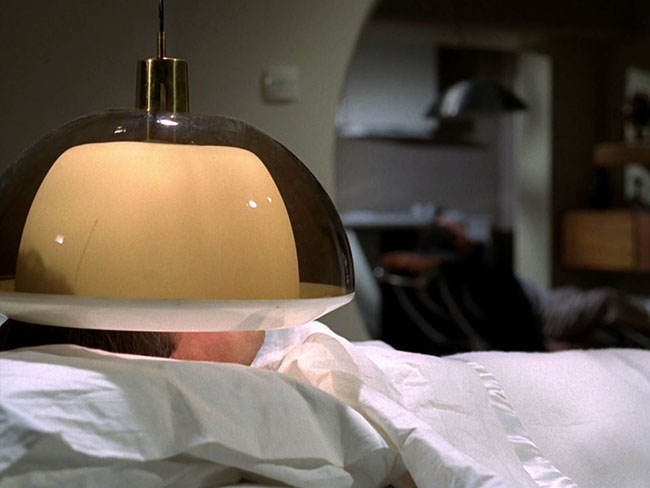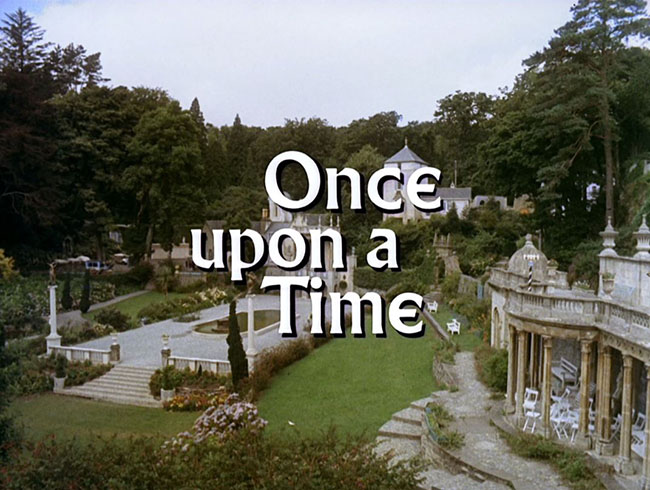
ONCE UPON A TIME First UK Broadcast: January 26, 1968 [episode #16 in transmission order] | Written by Patrick McGoohan | Directed by Patrick McGoohan
SYNOPSIS
Leo McKern’s No.2 (from “The Chimes of Big Ben“) has been brought back to make a final attempt to break No.6. No.2 is nearly apoplectic as the episode begins; he rejects his breakfast and is outraged to find Rover sitting in his chair, which implies that he’s just another prisoner being kept in his place. He decides to implement a program called “Degree Absolute,” though he’s only given a week to execute it. While No.6 sleeps, the lamp above his bed descends and covers his face, beginning a process which reverts him to an infantile state by morning. No.2 and the Butler (Angelo Muscat) lead the boyish No.6 (eating an ice cream cone) to the Embryo Room beneath the Green Dome, a locked chamber filled with props like a theater. It also contains a mobile caged prison with a kitchenette and toilet. Only one of them is expected to survive the week – “’till death do us part.” He outlines three goals:
A. Find missing link. [Find out what makes No.6 tick which they don’t currently understand.]
B. Put it together. [Determine why he resigned.]
C. BANG! [Death for one or the other.]
No.2 guides No.6 through Shakespeare’s 7 Ages of Man, restoring the Prisoner’s persona from childhood to schoolboy to young adulthood, fighting in a war, getting a top secret job for the government, and so on. Throughout these little plays, the Butler attends to their every need and enacts various supporting roles. We also see No.6’s unshakable personality forming and maturing in his youth: refusing to “rat” on his friend when the headmaster questions him; standing up to authoritarian questions over his exceeding the speed limit while on the job; holding his own when he’s captured behind enemy lines. And despite the fact that No.2 keeps circling back to the question of why he resigned, No.6 will not give a proper answer, nor will he even speak the number “six.” At the end of the week, the two are at each other’s throats with only minutes to spare, engaging in violence both physical and psychic. In the final second, No.2 collapses dead and the door unlocks and opens. The Supervisor (Peter Swanwick) enters and asks, “What do you desire?” The Prisoner answers, “Number One,” and follows the Supervisor out the door and down the hall.
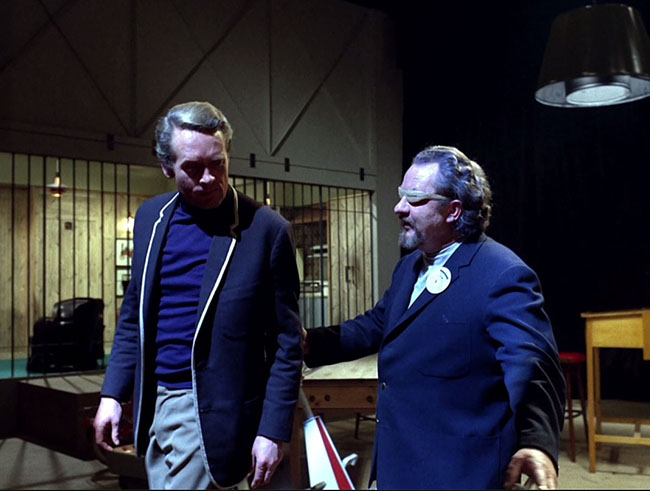
No.2 (Leo McKern) introduces No.6 to the Embryo Room.
OBSERVATIONS
“You are a member of the Village! You are a unit of society!”
“Once Upon a Time” was produced relatively early in the show’s run: it was the sixth to go into production. Originally it was intended as the finale of a first series of thirteen episodes. When it was decided that The Prisoner would come to an end after only seventeen episodes, OUAT was pushed back to become the penultimate story of the series, and the ending was supposedly rewritten to lead directly into “Fall Out.” I say “supposedly” because early draft scripts included on the Blu-Ray set all have the ending as you see it here.
This is an actor’s showcase, a chamber piece with only McGoohan, McKern, and Muscat. It’s a three-person play that has always reminded me of Waiting for Godot. McGoohan’s writing, here as in “Free for All” and “Fall Out,” leans heavily on avant-garde theater as an influence, and pages and pages of the script are reduced to nothing but short phrases, single words, or even numbers – as with Godot, it is almost incoherent unless performed. McKern rises to the challenge for this most theatrical of episodes, but suffered a nervous breakdown during production. You can pretty much watch it happen on screen. Name another TV show in the late 60’s that took this sort of risk or felt this genuinely dangerous. McGoohan, for his part, happily subverts his suave image, throwing himself into the Prisoner’s infantile side, then essaying the adolescent and young adult before turning quite savage on No.2 in the final ten minutes.
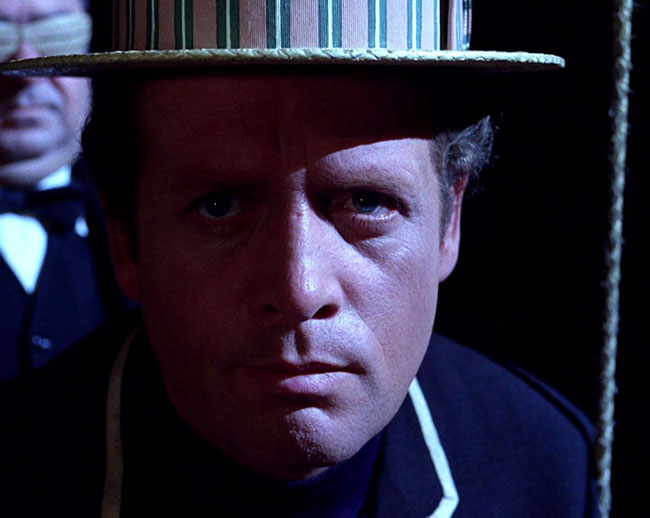
No.6 reverts to childhood.
Eccentricities abound. In the Embryo Room, No.2 and the Butler don slitted visors like those worn by Eskimos to avoid snowblindness. The Pop Apostle guide to the Prisoner speculates that the eyewear may be used to resist the “hypnotic lighting in the room” which keeps No.6 in his emotionally reverted state. Personally, I tend to think that there is something more symbolic in their use rather than a literal tool in the experiment. No.6 is under the harsh light, but No.2 and the Butler are protected: like scientists interacting with a subject inside a quarantine zone. Pop Apostle also notes that Villagers can be seen wearing these in “Arrival,” and further speculates that “they might be indications of ocular damage that occurred during experiments performed on those residents.” No.2 is also seen playing with a tinker-toy-like mechanism like the one the Labour Exchange Manager uses in “Arrival.” I don’t personally believe there is any symbolism in this toy, unless McGoohan is once more mocking the idea of technology and progress.
Progress: that’s McGoohan’s oft-quoted explanation of the penny-farthing bicycle symbol. As we learned from the alternate cuts of “Arrival” and “The Chimes of Big Ben,” the original ending credits of The Prisoner were to show the penny-farthing becoming the Earth and the Universe. The Earth was to spin toward the viewer until replaced by the letters POP (as seen in the alternate “Chimes”). If progress will lead to the world going “pop,” then the symbolism makes sense. “Pop Goes the Weasel” is a theme that frequently recurs in the score, drawing a connection between the “pop” of a jack-in-the-box – that terrifies and delights every little child – and the weighted penny-farthing symbol. Now in “Once Upon a Time” we finally get an acronym for POP…
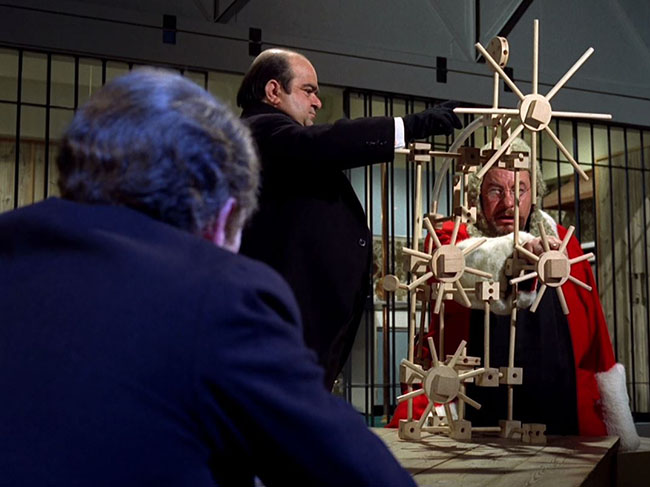
No.2 plays the Judge, while the Butler (Angelo Muscat) assists.
No.6: Pop goes the weasel.
No.2: Pop.
No.6: Pop.
No.2: Pop protect.
No.6: Protect?
No.2: Protect pop.
No.6: Pop.
No.2: Pop protect.
No.6: Pop.
No.2: Protect Other People.
No.6: Pop.
No.2: People’s own protection.
No.6: Protect Other…Pop.
No.2: Protect Other People. Why?
No.6: Pop.
No.2: Why why why why?
No.6: Pop goes the weasel…
(Note: I removed about two hundred “pops” from this exchange.) But what does “Protect Other People” mean? If we are to tie it into the technology-will-destroy-us theme (which is played out in some episodes such as “The General“), then perhaps that which “protects other people” is nuclear weapons. The nuclear arms race in the name of protection also marches the world toward annihilation. Think of the Doomsday Clock managed by the Bulletin of the Atomic Scientists (which recently advanced closer to “midnight”), or like the doomsday clock in this episode, which is hidden behind a curtain and counts down the week of “Degree Absolute,” with the promised ending of death for one of its combatants. Or perhaps the Prisoner once desired to protect other people, such as he protected his schoolmate, refusing to be “a rat.” Maybe he even resigned for the same reason – when he realized that his job was no longer protecting humanity, but putting it at risk.
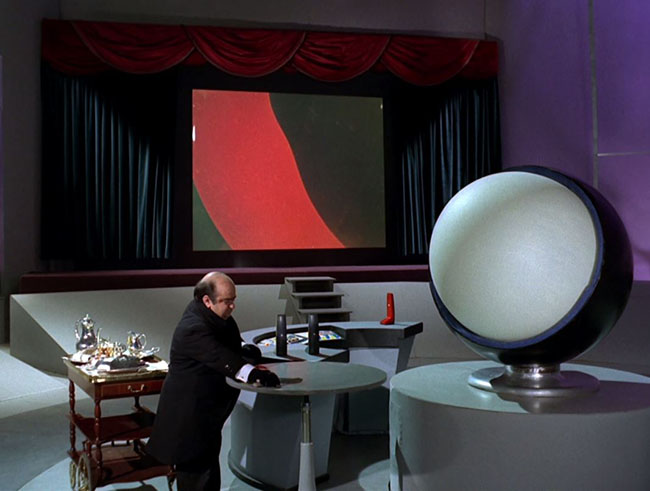
Rover occupies the globe chair.
No.6 does give another half-answer to the question of his resignation, as he did in “Chimes.”
No.2: Why did you resign?
No.6: For peace.
No.2: Peace?
No.6: Let me out!
No.2: You resigned for peace?
No.6: Yes. Let me out.
No.2: You resigned?
No.6: Yes.
No.2: For peace, you say?
No.6: Yes.
No.2: You fool.
No.6: Peace of mind.
No.2: What?
No.6: I resigned for peace of mind.
No.2: Why?
No.6: Too many people know too much.
No.2: Never.
No.6: I know too much.
A few moments later No.2 asks again, “Why did you resign?” and No.6 responds, “You have been told.” Which begs the question – would No.2 ever know the honest answer if he heard it, and would he ever accept it?
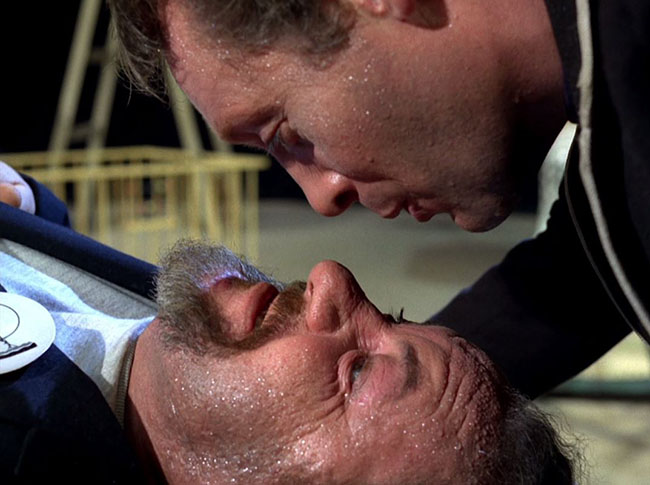
No.6 turns the tables on No.2.
The episode begins with humor – Rover sitting in No.2’s chair and filling it cozily, a sphere within a sphere – but there’s something nerve-jangling about the energy. No.2 only roars, his gentle humor from “Chimes” worn away. No.6 interrogates his fellow Villagers on the street in the most hostile manner. Something is about to happen, we can feel it: something big, something bad. No.6 kills in this episode. Not with the fencing foil that he takes in his hand and plunges at No.2 – who taunts him that he missed, even while oozing blood tells a different story – and not by the knife that he offers No.2 when things get even more serious. No, he kills him by pushing their manic, back-and-forth, sputtering dialogue into lethal sticks-and-stones. “Die!” he screams. And then he says his number. “Die! Six. Die!” His voice is demonic, chilling, all the more so because we don’t see his face – just No.2’s horrified reaction while a heart…slowly…stops.
“Once Upon a Time” is breathtaking television, one man’s unique creative vision brought to screens without cautious network notes. When I think of similar examples of a show locking the door and spending an hour with just a small number of characters (say, Homicide: Life on the Street‘s “Three Men and Adena” or Breaking Bad‘s “Fly”), The Prisoner stands out for pushing its writing to the level of the abstract, sometimes veering into the nonsensical, but always blisteringly psychological. Even when you can’t understand what No.6 and No.2 are talking about, you can feel that we are driving toward something deep, hidden, and forbidden – all of us, together. As is made even more clear in the next episode, we are plunging inside the Prisoner’s psyche. In “Once Upon a Time” he is deconstructed and then reassembled through the Seven Ages of Man. In “Fall Out” we will get even closer to this man – and to the heart of the Village.
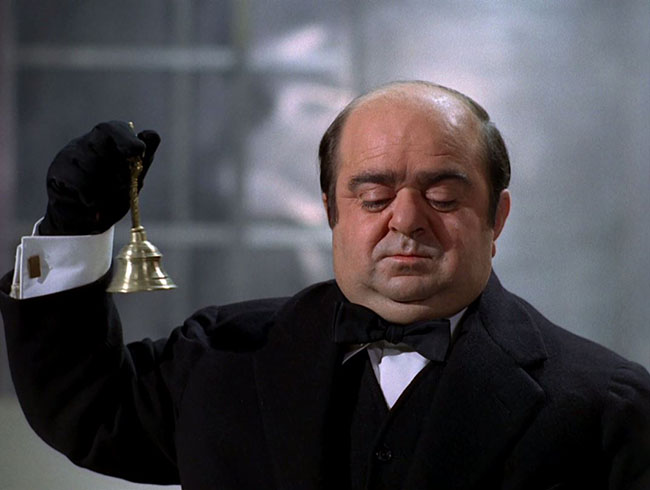
Muscat announces that breakfast is ready.
TITLES
The opening title “Once Upon a Time” is in a slightly smaller type than most, and the “i” has a dot in it, which violates one of the cardinal rules for the “Village” font.
The original title for this episode was “Degree Absolute.” The new title seems like it would be a better fit for “The Girl Who Was Death,” since that story is revealed to be nothing more than a storybook. Similarly, the title “Do Not Forsake Me Oh My Darling” could have been handed to the Western episode, “Living in Harmony” (since the former title is the hit song from High Noon), and “A Change of Mind” could have suited the mind-swapping plot of “Do Not Forsake…” Have I been thinking about this nonsense way too much? Oh, definitely.
METHODOLOGY
We’ve seen the glowing lamp above No.6’s bed before, when it’s been used to hypnotize him. (A similar hypnosis technique appears in On Her Majesty’s Secret Service.) This is the first time it’s completely swallowed his face and reverted him to his youth. “Degree Absolute” is the technique, tied explicitly to the Embryo Room, from which only one man can emerge alive. The science is unclear. This is a metaphysical duel.
Late in the episode, No.6 has an almost-broken No.2 sprawled on the floor when he confronts him about the nature of the game:
No.6: You chose this method because you knew the only way to beat me was to gain my respect.
No.2: That is correct.
No.6: And then I would confide.
No.2: I hoped that would come to trust me.
No.6: This is a recognized method…
No.2: …used in psychoanalysis. The patient must come to trust his doctor, totally.
No.6: Sometimes they change places.
No.2: Which is essential in extreme cases.
No.6: Also a risk.
No.2: A grave risk.
No.6: If the doctor has his own problems.
No.2: I have.
No.6: That is why the system is known as “Degree Absolute.”
No.2: It’s one or the other of us.
No.6: Why don’t you resign?
No.2: You’re very good!
WIN OR LOSE?
This is the final win for No.6, climbing to the top of the Village – or, rather, below, since everything important in The Prisoner is underground. (Kind of like the unconscious, huh?) Next we will discover what reward awaits him underground.
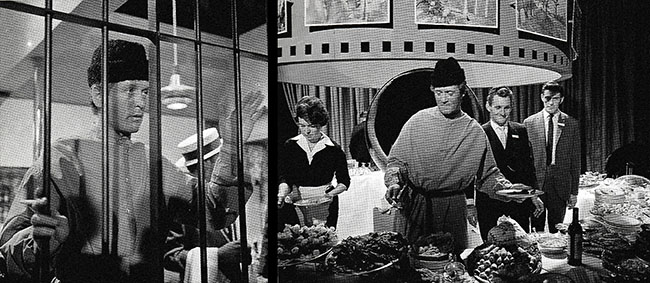
Patrick McGoohan entertains the press at the September 1967 press conference.
THE PRESS CONFERENCE
In September 1967, just before The Prisoner debuted, Patrick McGoohan hosted a most unusual event for the press. Here is how Alain Carrazé and Hélène Oswald described it in their 1989 book The Prisoner: A Televisionary Masterpiece:
The guests were first taken to the studios at Borehamwood, where they were shown the first episode, “Arrival.” When they left the screening room, they were directed to a room specially prepared for them: behind the bars from “Once Upon a Time,” Patrick McGoohan was waiting for them, dressed in the red tunic he wears for the Kosho game, with a fur hat on his head and with Angelo Muscat at his side. And it was through the bars that he addressed the journalists. But his replies to their numerous questions were more than evasive; it is said that he asked even more than they did. Then he came out of his prison and invited them to a buffet served by waitresses dressed like the maids in the Village, and laid out on the circular desk from Number 2’s office, with his spherical chair in pride of place at the center. An exhibition of [Jack] Shampan’s sketches for the sets and various props from the series – including a mini-moke – completed the whole thing. There was even a large penny-farthing in one corner, and Alexis Kanner was able to demonstrate how to ride it. Finally, McGoohan, who had slipped out for a while, reappeared dressed as a cowboy, ready to start shooting “Living in Harmony.” And so, fairly baffled but above all frustrated, the journalists were taken back to London.
QUOTES
No.2: This is it. For better or worse. Who knows? One week, one teeny-weeny week my boy. Neither of us can leave. Till death do us part. And I’ve brought it on myself. Who knows?
No.2: Even as a child, there is something in your head that is a puzzlement! I intend to discover it.
Supervisor: We shall need the body for evidence. What do you desire?
No.6: Number One.
Supervisor: I’ll take you.

THE END CREDITS
It wasn’t out of the ordinary for a TV show in the 60’s to include a cute little tag at the very end, some signature to remind the viewer what they’ve been watching. But the one offered by The Prisoner week after week was in-your-face and crushingly downbeat. From an aerial view of Portmeirion, a Pythonesque cut-out of McGoohan’s face silently flies toward the viewer, about to escape the Village until bars slam shut over it with a deafening clang. Since so many episodes ended with an aborted escape attempt from the Prisoner, this symbolic animation served to rub salt in the wound. It also reminded viewers that not only would the Prisoner never escape, but that was the show’s whole thing. People were practically dared to come back for another helping next week. How much punishment could they take?

While Ron Grainer’s opening credits theme comes trumpeting in for a reprise, a wheel spins against an abstract desert backdrop with Romanesque statuary, reminiscent of the busts with hidden cameras at the perimeter of the Village. The wheel settles into its spot where the penny-farthing bicycle will be assembled piece by piece as the credits unfurl. McGoohan’s production company, Everyman Films Limited (named after the 15th century Christian morality play Everyman, or The Summoning of Everyman), receives a prominent credit. For this episode, so does Angelo Muscat, getting some well deserved attention. When the bicycle is complete, for a brief second all parts but the wheels disappear, a vestige of the original version in which the wheels would transform into the Earth and the Universe until everything goes POP! Instead, we see Rover bubble up from beneath the sea and surface just as the theme becomes triumphant. As he bounces along the water, it’s like he’s saying, “So long, kids! See you next week!”
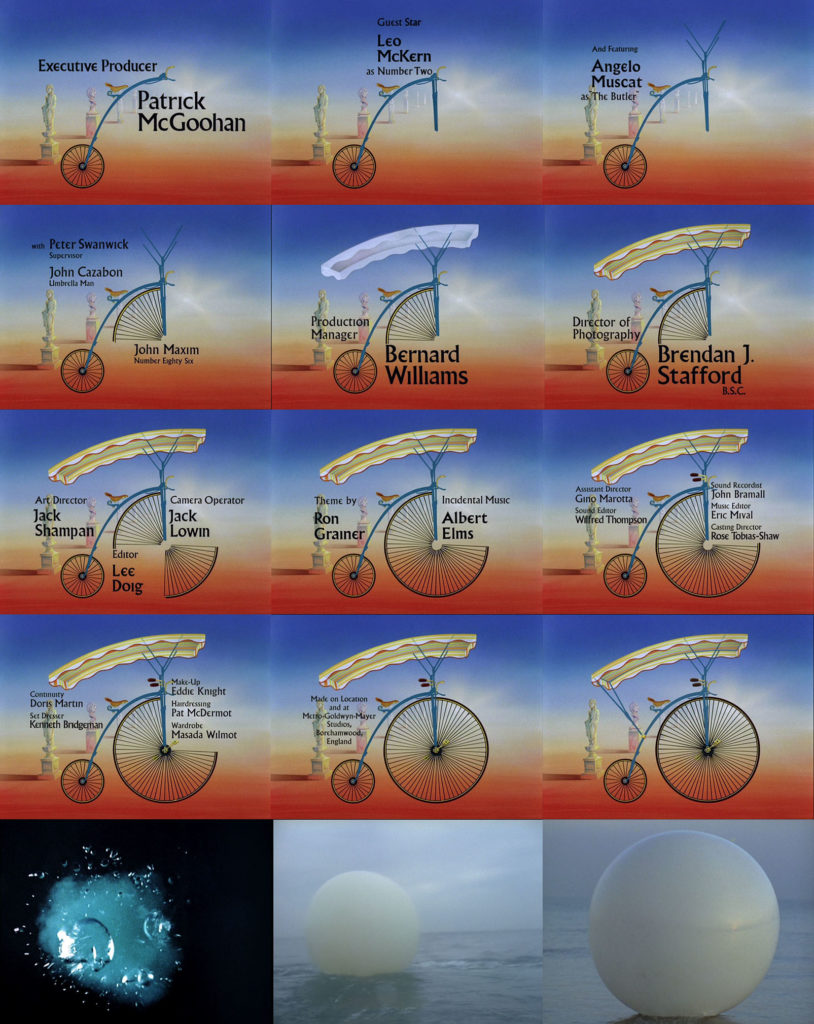 UP NEXT: FALL OUT
UP NEXT: FALL OUT

